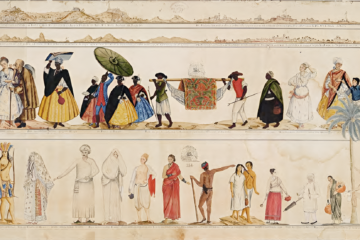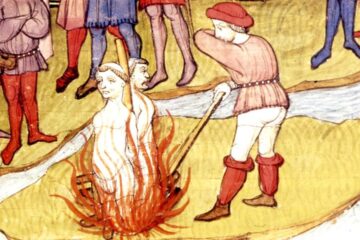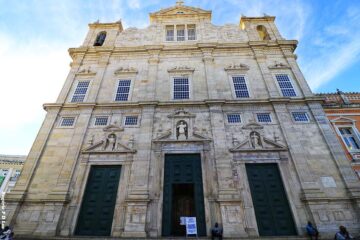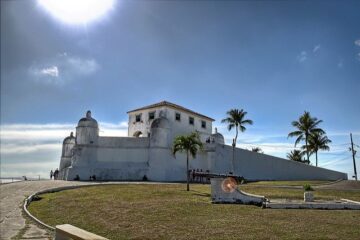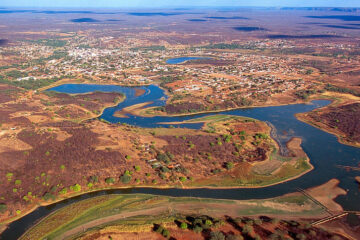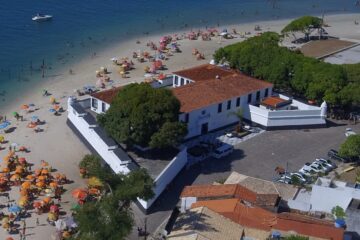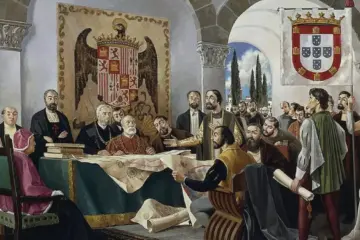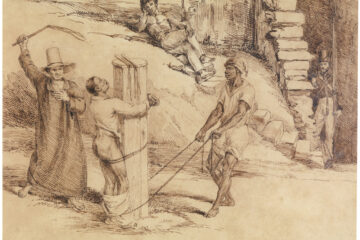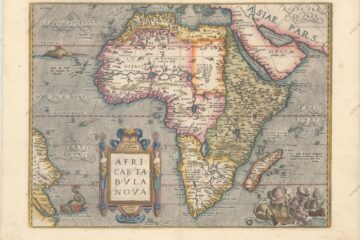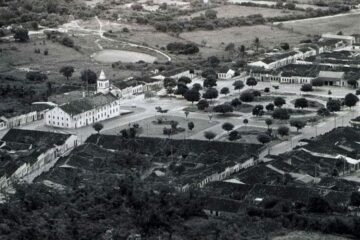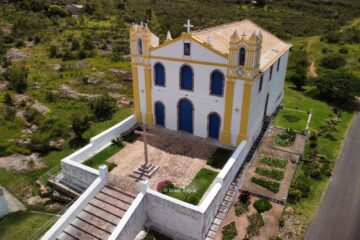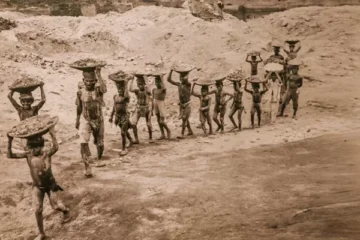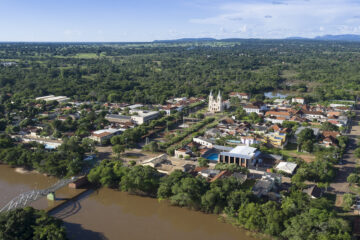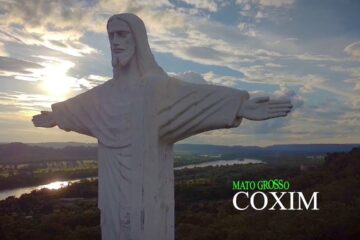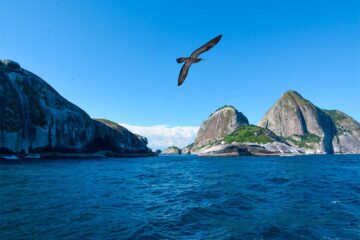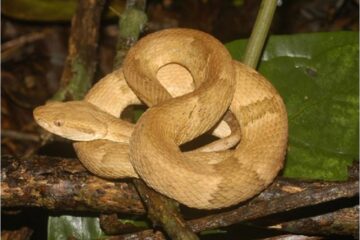The Trio Elétrico of musicians Dodô and Osmar celebrated their 64th anniversary in 2015, while axé celebrated its 30th anniversary. Without this sound truck, the Bahian Carnival would definitely not be the same.
Carnival, one of Brazil’s largest popular festivals, is a vibrant reflection of the country’s culture and diversity, and the Trio Elétrico has become a symbol of this celebration.
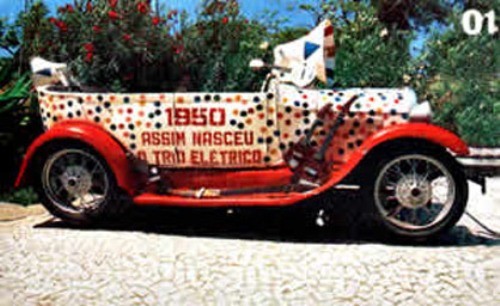
Modest beginnings
Those who frequent Bahia’s festival circuit and are impressed by the structure of the mobile stages can’t imagine that the trios started out as nothing more than a car with a amplifier connected to the battery.
And it wasn’t a trio. It was a duo. And what a duo it was: musicians Dodô and Osmar (after whom Salvador‘s parade routes are named) were the creators of this concept.
Video “History and evolution of the Trio Elétrico”

História e evolução do Trio Elétrico
The birth of the Trio Elétrico
It all began in 1951, when the Recife club Vassourinhas invited the two musicians to play at the Salvador Carnival in a 1929 Ford that had been restored for the occasion. The success with the audience was enormous.
The following year they invited the musician Temístocles Aragão to take part in the carnival. It was with this formation that they began to be called Trio Elétrico.
The name caught on, and other bands that played in open cars were given the same name. Armandinho, Osmar’s son, recalls that as time went on, the vehicles carrying the musicians grew in size to keep up with the growth of the bands participating in the festival.
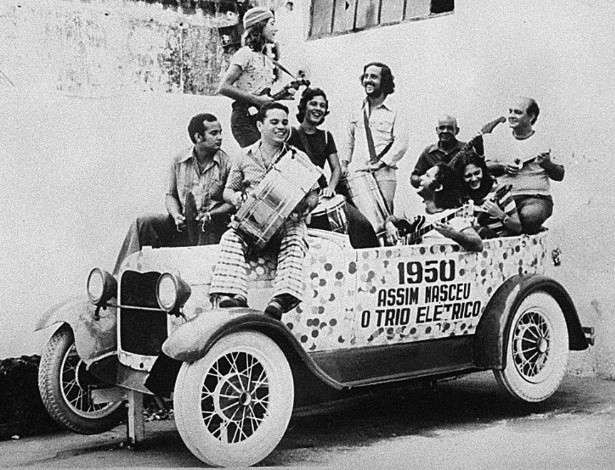
Cultural and musical influence
Salvadorans Adolfo Nascimento (“Dodô” – 10/11/20) and Osmar Alvares Macêdo (22/03/23) were responsible for one of the most fruitful chapters in the history of northeastern and even world roots music.
As well as electrifying Pernambuco’s frevo, they managed to create a new way of bringing the music to the revelers of Salvador’s carnival, and later to the whole of Brazil.
This innovation not only changed the dynamics of the festivities, but also influenced other musical genres and festivals in the country and abroad.
Technological development
The duo were at the forefront of technological developments in music, creating an electric guitar in 1942, the Bahian guitar, a year after the American Les Paul built his first prototype electric guitar. This innovation was a milestone that influenced the sound of many artists to come.
The elevation of Frevo
The “electric duo” also elevated frevo to an instrumental level never before imagined by Pernambucans. Dodô and Osmar set new standards of rhythm and would later incorporate other northeastern musical genres into the Trio Elétrico‘s “carnivalising” revelry, which changed the face of carnival in Bahia and later throughout the country.
The impact of the 1951 parade
On 29 January 1951, the Monday before Carnival, Dodô and Osmar had another key experience when they witnessed the parade of the Clube Carnavalesco Misto Vassourinhas from Recife, which stopped in Salvador on its way to Rio.
Vassourinhas specialises in frevo, a Pernambuco musical style with a marching rhythm that has been part of Rio de Janeiro’s carnival since the 1930s.
The event, blessed by the authorities and supported by sponsors, radio stations and the city’s Pernambuco community, brought together an unprecedented number of people in the centre of Salvador.
The following events were of great historical importance for the Bahian Carnival: Osmar’s old Ford ’29, nicknamed Fobica, normally used to transport metal parts, was transformed into a mobile stage, allowing the duo to play Pernambuco frevo classics at high volume with their exotic electric sticks during the festivities.
Fobica and the Carnival Revolution
Equipped with a 2-kilowatt generator, decorated with carnival motifs and loudspeakers mounted on the front and back, the musical Ford arrived on the scene at around four in the afternoon on Carnival Sunday.
Accompanied by six percussionists, including Armando Mereilles, Osmar’s father-in-law, dressed as a Hawaiian ‘ula ula’, the Fobica entered Chile Street, just off Castro Alves Square, to join the motorcade in the official parade.
This was the first time that Bahia’s popular carnival had openly taken a place in the official part of the festival, which, although public, was reserved for the activities of the elite.
It seems that the Vassourinhas parade five days earlier, with the frevos so enthusiastically received by the population, served as a kind of rehearsal for the debut of Dupla Elétrica and its Fobica.
The birth of a new musical genre
The episode, which left everyone – including Dodô and Osmar – in a state of shock, marked the birth of a new musical genre (today known as frevo do trio, frevo novo , frevo, baiano, etc.) and, at the same time, a new way of playing the Bahian Carnival, which would later be known as Trio Elétrico.
Development of the Trio Elétrico
The following year, Dodô and Osmar replaced the Fobica with a Chrysler Fargo pickup and changed the formation from a duo to a trio, adding a triolin, also electrified in the manner of electric sticks, played by their friend Temístocles Aragão. They also changed their name from Dupla Elétrica to Trio Elétrico.
A year later they had a lorry with eight speakers, fluorescent lights and generators, sponsored by the local soft drink company Fratelli Vita (now Brahma).
In the mid-1950s, as other bands began to copy the concept, the term Trio Elétrico became generic.
The golden age and popularisation
The following decades brought a flood of vans and lorries transformed into mobile stages, growing in size, sound system and decoration.
When Dodô and Osmar stopped parading in 1960, the phenomenon was already consolidated and continued to grow in the hands of other trios, such as Tapajós, organised by Orlando Campos from the second half of the 1950s.
The current legacy and future of the Trio Elétrico
Today, almost 60 years later, the descendants of the old Ford 29 have evolved into brontosaurus-sized trucks, carrying equipment with outputs of up to 200 dB, loudspeakers on all four sides, bands of up to 25, plus dancers on their roofs shaking the crowds dancing around them, and scientific papers published on the long-term effects of exposure to their sound.
The fame of the Trio Elétrico far exceeded that of the Bahian guitar. Today, artists such as Ivete Sangalo, Chiclete com Banana and many others continue the tradition of the Trio Elétrico, innovating and pushing its boundaries, ensuring that this form of joy and celebration will continue for generations to come.
Publicações Relacionadas
Rapadura: A Sweet Treat from Northeastern Brazil
Why go to the Brazilian Northeast?
Jorge Amado's Life and Literary Contributions
Casa Grande & Senzala: The Work of Gilberto Freyre
Tropical flowers are grown on a large scale in northeastern Brazil
Fine Arts in the Brazilian Northeast
José Américo de Almeida: A Brazilian Literary Icon
Tracunhaém and Its Rich Clay Handicraft Tradition
History of the introduction of Portuguese tiles in Brazil
Music and Rhythms of the Brazilian Northeast
Maranhão's handicrafts have more than 400 years of tradition
Historic Towns in the Northeast: Explore the Past
São Jorge dos Erasmos Sugar Mill: A Landmark in Brazil
Influences and main dishes of northeastern cuisine
History of the Brazilian Northeast
Northeastern architecture marked by typical features of colonial structures
History and origin of Northeastern literature and biography of the main authors
Cultural Aspects of the Northeast Region of Brazil
This post is also on:
![]() Português
Português ![]() English
English ![]() Deutsch
Deutsch ![]() Español
Español ![]() Français
Français


